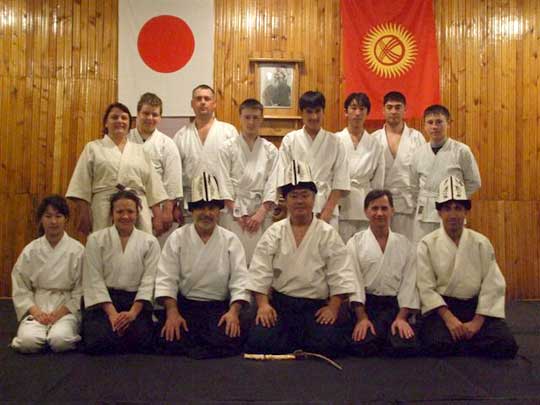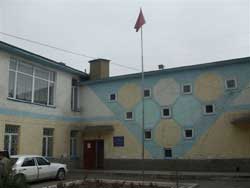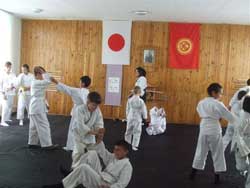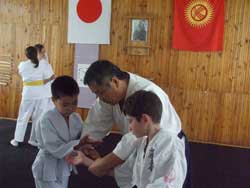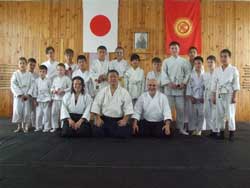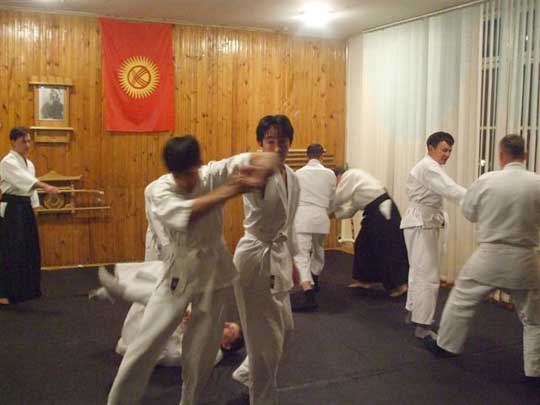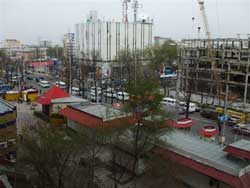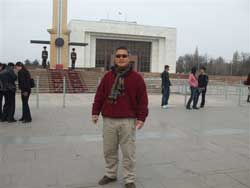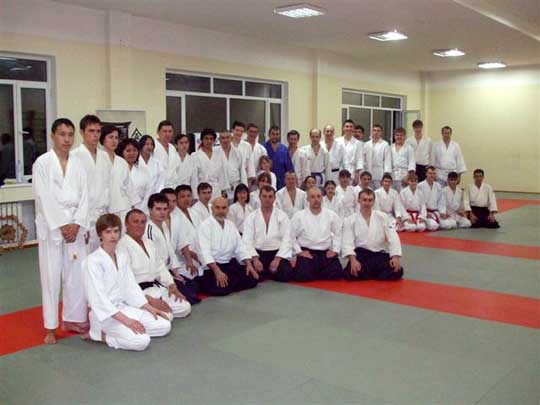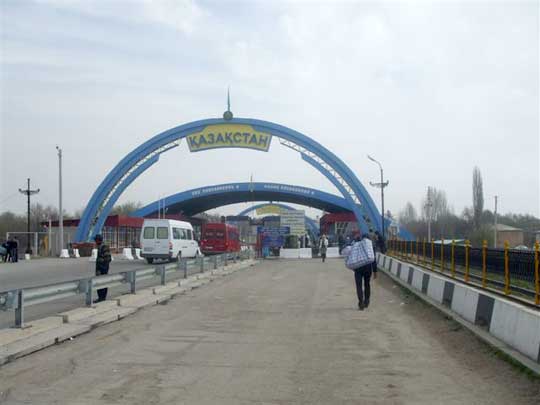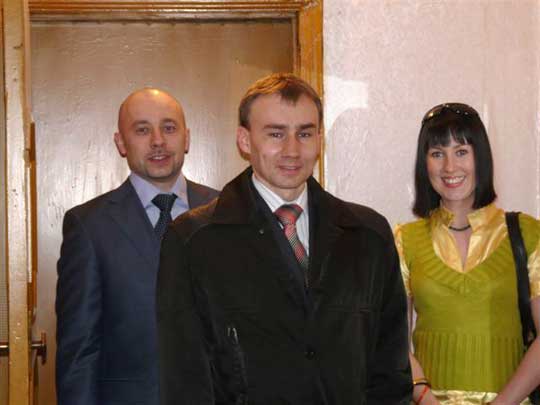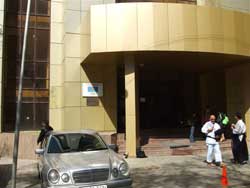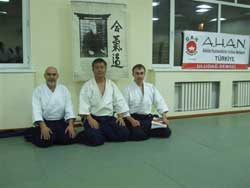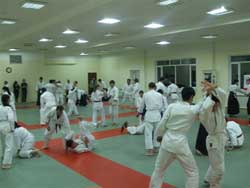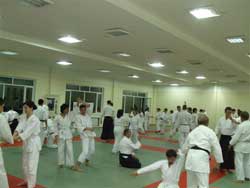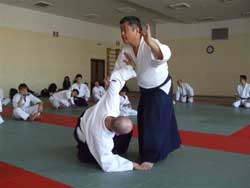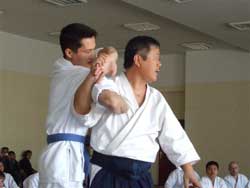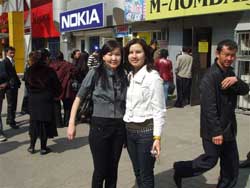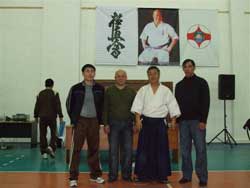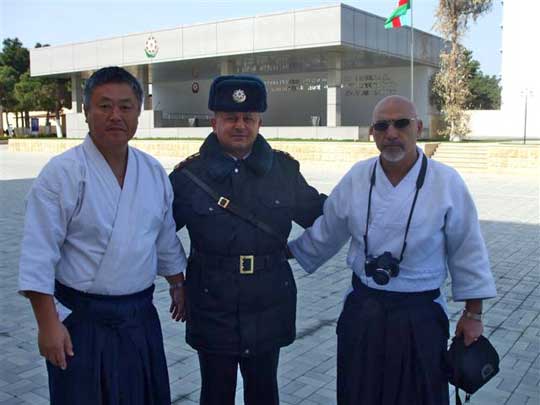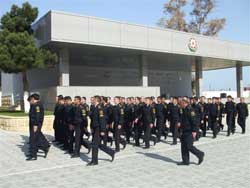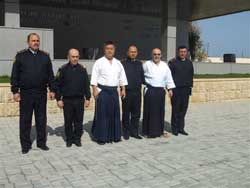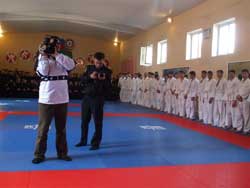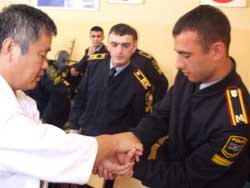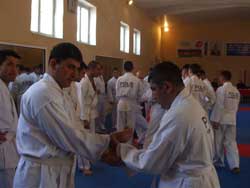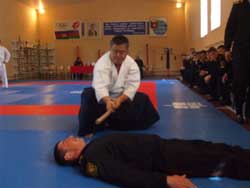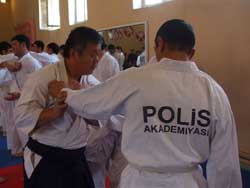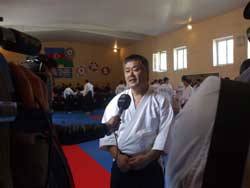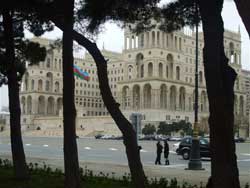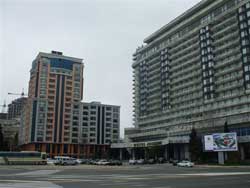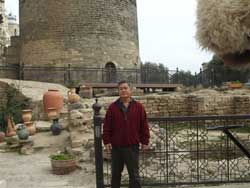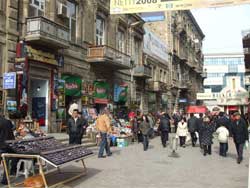Republic of Kyrgyzstan
Teaching Aikido at Children’s Orphanage Care Center
Bishkek, Kyrgyzstan
March 24th -25th, 2008
Our dojo is part of an orphanage care center that cares for about 100 children from a young age through their middle school years. After middle school, young people in Kyrgyzstan are selected to move on to technical schools of which we assist in their placement.
My name is Reznikov Andrei and I am the founder and main Aikido instructor for the Aikido Center of Bishkek. I began my practice of Aikido in Dashken Uzbekistan in 1995. In the year 2000, we opened this Aikido dojo in Bishkek. My primary occupation is as a psychologist and I practice at the National Hospital in Bishkek. In my country, drugs and alcohol are serious problems and much of my practice revolved around the treatment of these ailments.
My partner in this dojo is Mrs. Irina who lived in Wakayama Prefecture, Japan as part of a JICA (Japan International Cooperation Agency) program. She hold the winning title in the Japanese language and speech contests in our country and works with the many Japanese companies and the Japanese culture center here in Bishkek. Both Irina and here children practice Aikido at our Aikido Center of Bishkek where we hold three classes a week.
Our dojo has limited funds available to us; therefore our small practice space is covered with cushions covered with a nylon cover. We hold classes for adults in the evenings and classes for children during the days. The number of students we have practicing averages about 30 including adults and children. Since our practice space is small, we divide our classes into two groups so that everyone has room to practice.
- Outside the care center where Aikido classes are held.
- Children practice very sincerely.
- Teaching with actions not words.
- With the children.
- view of town
- Iin front of statue of Lenin
“Sometimes Aikidoists pay a great deal of money to gather for seminars to work on improving their own techniques or practice. They believe that what they are doing is principled and spiritual and that they are acting in a spirit of harmony; unfortunately they are communication only amongst themselves.
I believe however, that this type of practice can be shortsighted in the best of circumstances, wrong sighted if these events are organized by people with ulterior motives and personal ambitions. Students that attend these seminars may be practicing hard but I do not believe they are reflecting on meaning of their practice. I wonder if they are working towards not only understanding themselves but at the same time reaching out to meet and have a positive effect on the world around us. These closed seminars remind me of scientists in a research laboratory making an “Aikido vaccine” to share only with other scientists in the laboratory. They congratulate themselves on what they have discovered but never share the vaccine with those who might benefit from it outside nor do they test the vaccine in the world outside of their laboratory to see what effects of their vaccine might have in the greater community.
As a psychologist I think you can relate to my observations. Every day you are teaching on the front lines. Study your practice well to see if your teaching is effective in benefiting your community. This is your challenge and your practice. Discuss what you are teaching with your peers and add new ideas to be the most effective you can be. In this way you can develop a sense of flexibility and responsiveness to the children and adult students entrusted to your care. In every case you can use Aikido technique and spirit to raise the spirit of your community. This I think is Aikido Alive! , and is the most beneficial to all of our communities.
Your dojo is not large and struggling makes this a difficult time in your Aikido teaching career. Today you sew the seed in the children you teach. Years from now these children will become adults and carry with them into adulthood the lessons you are teaching them today. We plant seeds of Aikido today for the future. This is one of the principle ideas of AHAN and is one of the principle reasons I have traveled so far to help you today. It is part of my own practice or shugyo too”.
We all received a great deal of inspiration and new-found enthusiasm and confidence from Homma Kancho’s visit to Bishkek, and look forward to applying what we have learned to our practice here. Homma Kancho and party left the following morning for a five hour drive to Almaty, the capital city of Kazakhstan. From far away in America, Homma Kancho had come to visit us in Kyrgyzstan, and our children too will have memories to cherish from this visit for a very long time.
Written by
Reznikov Andrei Sensei
Aikido Center of Bishkek
Bishkek, Kyrgyzstan
Republic of Kazakhstan
Almaty City Aikido Center
March 26th-28th, 2008
Leaving Bishkek, it took us about an hour by taxi to reach the border of Kazakhstan and another four hours before we finally arrived in Almaty, the old capitol of Kazakhstan. We were dropped off by our taxi driver at a bus stop outside of Almaty to wait for the Almaty staff to pick us up and bring us into town. On their way to meet us was Igor Antokhin Sensei of the Republic of Kazakhstan Traditional Aikido Association www.kata.kz and English translator Ms. Alexandra.
- At the Kazakhstan border.
- Melygin Sensei, Igor Sensei, Ms Alexandria.
The seminar in Almaty was scheduled to be held in a large sports compound building facility which also houses the Kazakhstan Olympic Committee offices. The second and third floors of this facility both hold one hundred tatamii mat covered practice spaces. The 3rd floor space is used by Igor Antokhin Sensei and the 2nd floor is used by Melygin Slava Sensei both for the practice of Aikido on alternating days. There are about 200 members in the Kazakhstan Traditional Aikido Association, so the seminar was planned to split the classes into three groups of about 60. Professor Sukiev of the Kazakhstan Academy of Sports and Tourism has been a great promoter of the Aikido in Almaty and helped to arrange the very nice spaces in the sports compound facility for practice by members of the Kazakhstan Traditional Aikido Association. Before these arrangements were made, the KTAA practices were limited to parks and empty buildings which made for much more challenging conditions. The roots of the KTAA link back to the direct students of the late Michio Hikitsuji Sensei in Japan. They practice Masakatsu Jodo or Masakatsu jotechniques which are uniquely related to Hikitsuji Sensei’s teachings.
- Building housing the dojo.
- Ali sensei, Homma Kancho, Igor Sensei.
Homma Kancho teaching
By the third class, everyone seemed to relax and student’s movements became larger and more fluid as they enjoyed practice. Themes for the seminar included “The stimulation on our spirits and minds through repeated practice of Aikido” and on a more technical side, “the structure of Aikido; how to organize and group techniques”. Homma Kancho taught with humor and wise understanding relating many first-hand stories about the history of Aikido and his time spent with the Founder of Aikido Morihei Ueshiba. Being a journalist and an Aikidoist, I have attended many Aikido seminars and watched many videos and other media presentations on the subject yet I have never experienced the kind of practical yet innovative and inspiring teaching style of Homma Kancho.
Being privy to a lot of internet exposure, Kazakhstan students had many interesting questions for Homma Kancho including “Is it true that the Founder smoked cigarettes”, and “Was every instructor that practiced at Hombo dojo an uchideshi?” Homma Kancho was very thoughtful, patient and clear in his answers. He first responded with a joke, “If you are a smoker I think you would be glad to hear that the Founder smoked cigarettes, that would get you off the hook!” He then replied thoughtfully, “The Founder was a pioneer in Japan and spent some of his younger days in the wilds of Hokkaido Island. Today in Shirataki village, Hokkaido (a village of which he helped to build) is a museum that houses tobacco pipes and tobacco cases that belonged to the Founder. The Founder did smoke a pipe in his younger days, but we need to put this in a context of the time and the place. At that time in Japanese society it was quite fashionable for men to smoke and it was a celebrated social ritual for men to smoke together on occasion. Also remember that these tobacco pipes are not like cigarettes. They held a small pinch of tobacco that could be smoked in two or three puffs. Smoking these pipes on occasion cannot be compared to cigarette smoking today. Anyway, I would not recommend believing that smoking is a good idea just because the Founder smoked a pipe on occasion and still lived to be 80 years old! This made of the attending students and instructors laugh!
On the second question Homma Kancho answered, “No, not all Hombu instructors were uchideshi. Remember uchideshi are students who live at the dojo and practice Aikido as a way of life twenty four hours a day; being an uchideshi is more like living in a monastery. For about the last three years before the Founder died, there were no uchideshi at Hombu dojo at all. Shihan or shidoin (instructors in training) about forty years ago at Hombu dojo were paid about $150-$200 per month and lived in very small inexpensive studio apartments near the dojo. Some of these apartments were no more than a three tatamii mat space with shared toilet and kitchen facilities but they were considered as independent housing. These shidoin (intern instructors) would go to the dojo daily, but no one lived at the dojo at the time. Anyway, anyone receiving a salary by definition would not be an uchideshi. At that time, the Founder lived in Iwama, and many of theseshidoin were lucky to receive instruction from the Founder more than a few times a month. I was the Founder’s otomo (attendant) at that time and every time I traveled with the Founder from Iwama to Hombu dojo in Tokyo the shidoin would pull me aside and ask me what kind of mood the Founder was in. If the Founder was not in a good mood that day, most of the shidoin would disappear leaving only the shidoin scheduled to teaching classes that day to receive the Founder.
One high ranking Japanese shihan that currently lives in the United States, lived for a time in the Hombu dressing room ceiling crawl space. No joke. It was at the time they were demolishing parts of the old dojo to make room for the new dojo at Hombu. They made a temporary make-shift dressing room for students to change in at the old dojo and there was a crawl space between the makeshift ceiling and the roof. This was where he slept, and when I discovered his secret sleeping quarters he made me swear not to tell the Founder he was sleeping there. Now he says he was anuchideshi of the Founder, but I don’t think it counts when the Founder did not even know he was staying there!
Many who lived during the period toward the end of the life of the Founder have now also passed away. I was young at the time however and am still a living testimonial to what really happened and what did not happen at that time in our Aikido history. There are also still people living in Iwama that knew the Founder directly and can testify to the last years of his life in Iwama.
- Kazakhstan AHAN exchange students
- Directors of Kazakhstan Kyoukushin Karate
The Hombu shidoin are more an authority on the life of the late Founders son, the late Kishomaru Ueshiba.”
In the summer of 2007, eight students from Kazakhstan lived and worked at Nippon Kan General Headquarters. During this visit to Kazakhstan, four of these students stopped by to visit Homma Kancho while he was in Almaty. Kyoukushin Karate students who also practice in the same complex, also paid a visit to Homma Kancho taking a few moments to share in friendly communication and photos with him and all of the Aikido students in attendance.
In the Central Asia Region including Kazakhstan, “Real Aikido” is practiced. “Real Aikido” is headquartered in Yugoslavia and is an interpretation of Aikido taught by a 10th dan ranked leader in these areas. “Real Aikido” is completely different in spirit, image and style from the Aikido taught by the Founder Ueshiba and in my view is a misinterpretation and misunderstanding of the true meaning of Aikido as the Founder taught. It is very difficult to teach the Aikido philosophy of the Founder in a “Real Aikido” environment.
After the seminar, we gathered at a traditional Kazakhstan restaurant to celebrate and we all promised to meet again with hopes for the future development of the Kazakhstan Traditional Aikido Federation. The next morning Homma Kancho and party traveled from Almaty to the capital city of Astan and then flew onward to Baku, Azerbaijan for the last leg of this Central Asia Tour.
Written by Azerbaijan Journalist
Necef Hasanov
Republic of Azerbaijan
Teaching at the Azerbaijan National Police Academy
March 30th-31st, 2008
Homma Kancho and his party left Kazakhstan about 2:00 am and arrived in Baku, the capital city of the Republic of Azerbaijan later that day. The next day, March 30th, Homma Kancho taught officers and cadets at the National Azerbaijan Police Ministry of Internal Affairs. For Homma Kancho this was his second visit to the Academy. Homma Kancho and party were picked up at the hotel for the fifty minute drive to the Academy by a Colonel of the Police Department Ferhad Memmodov and Gadil Zamznof, also a police colonel and Vice Principal of the Academy, and Sports Department Director Hafiz Haciyev met the group upon arrival.
- Marching to the dojo.
- With police academy faculty.
Azerbaijan is growing, and with growth comes the need for additional police officers so the Academy facility and staff have also grown since Homma Kancho was here last in 2005. We were given a guided tour of the academy facility and the martial arts practice dojo before Homma Kancho demonstrated and instructed select Aikido techniques applicable for police or military use to about 40 cadets while about 100 others watched carefully from the gallery. Before his demonstration, Homma Kancho began, “In the old days, VIP and crowd control officers used more force to control outbreaks of violence, but today there is much more of a focus on human rights violations. With today’s use of cell phone cameras and the internet as a world-wide vehicle real time news distribution, a snapshot of a technique can be misread as overly forceful. For all of these reasons, changing to softer yet effective defensive techniques is important. Your job is to protect and maintain public security, but a little bad press can misconstrue your actions and intent if the techniques you use are too hard. Especially officers involved in VIP protection need to be skilled in techniques which ultimately result in maximum effectiveness yet utilize minimum effort and minimum damage to others. This will be the focus and purpose and practice in seminar today”. The classes taught by Homma Kancho were filmed to be used in future training at the academy. Local Television stations wer also on scene and the footage was run many times on prime time television.
- Setting up for Kancho’s speech before his demonstration
- Homma Kancho’s interacts with the audience too.
- Practice with cadets.
- Kancho’s demonstration on the importance of “leg power and control”
- Mune tori techniques.
- Kancho interviewed for TV.
After practice a meeting was held to discuss how the academy could implement the practice of these type of techniques and their applications in future curriculum studies. The next day, Homma Kancho and Ali Sensei left for Turkey.
By this time I had traveled to Kyrgyzstan, Kazakhstan and Azerbaijan with Ali Sensei and Homma Kancho serving as translator and guide. One thing hat I learned during this trip was how important physical condition is to being able to function at such a demanding international level. Before all off the seminar practices had been finished, Homma Kancho was very strict about monitoring his own diet and needs for personal rest and physical training. He also controlled the amount of alcoholic beverages he consumed and avoided “risky” foods for his system. Most of our hotel rooms were on the upper floors and Homma Kancho used the stairs to reach his quarters sometimes walking up eight or more flights of stairs to return to his room. Just when I was beginning to think that Homma Kancho was not fond of the food in our countries or did not trust our elevators, our extended seminar practice schedule came to a close. Once his job was done, Homma Kancho said, “ I travel not as a tourist but as a professional martial artist in training, and my conditioning and habits are not unusual during these times. It takes too much time to take a hakama on and off if I was to upset my stomach before our teaching schedule has ended!” Homma Kancho had visited Nepal, Turkey and these three Central Asia countries on this trip in three weeks time. Dealing with jetlag and the time changes is difficult enough without the added rigors of teaching and practicing Aikido halfway around the world. I truly respect Homma Kancho’s endurance and focus; he indeed is a true martial artist.
At out farewell party, Homma Kancho “switched hats” so to speak from an Aikido Sensei to a restaurant owner as he focused on sampling the tradition foods of Azerbaijan and the vodka this area is famous for. “Okay”, he said, “Now it is time to think about my other job…”
- Azerbaijan Parliament near the Caspian Sea.
- Azerbaijan building boom.
- Many ruins in Azerbaijan.
- Antiques and souvenirs.
Written by Azerbaijan Journalist
Necef Hasanov


